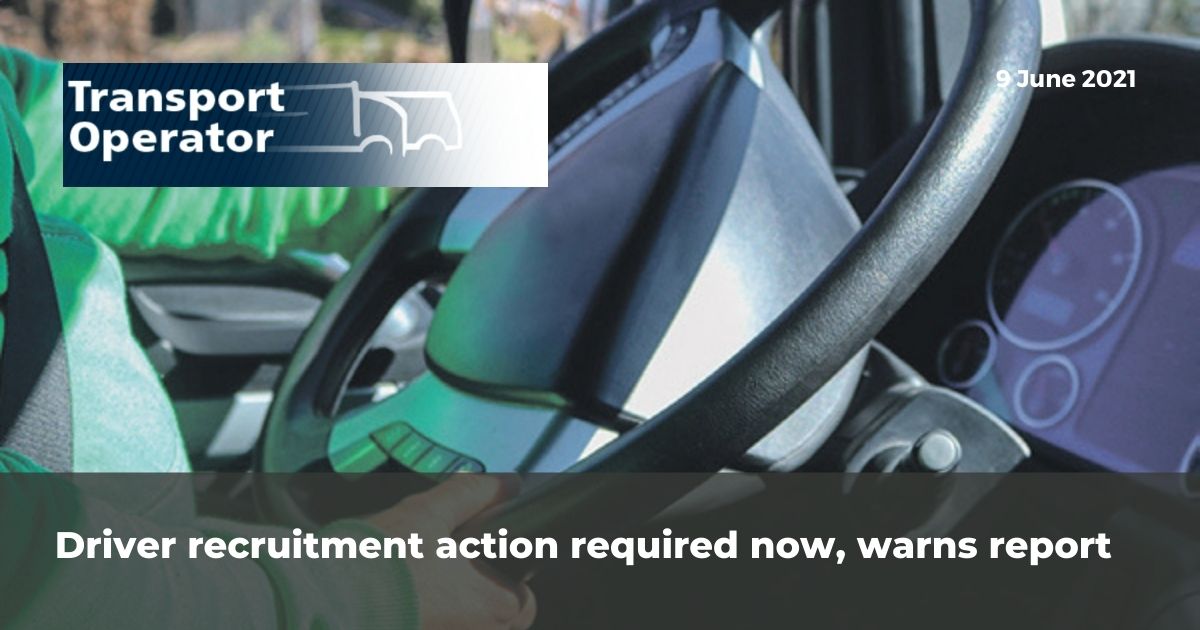Driver recruitment action required now, warns report
Driver Require latest report mentioned in Transport Operator article
 A combination of Covid-19, economic recovery, Brexit and continuing poor pay and conditions could lead to a severe shortfall in available truck driver numbers this summer and beyond, warns the latest report from recruitment agency Driver Require’s CEO Kieran Smith.
A combination of Covid-19, economic recovery, Brexit and continuing poor pay and conditions could lead to a severe shortfall in available truck driver numbers this summer and beyond, warns the latest report from recruitment agency Driver Require’s CEO Kieran Smith.
Entitled A Perfect Storm of Elevated Demand and Reduced Supply in the UK Haulage Sector in 2021, it sets out the thoughts and findings of a group of industry participants and observers as the consequences of exiting the European Union and emerging from the Covid crisis become clear.
Mr Smith set up a ‘think tank’ consisting of representatives of the Recruitment & Employment Confederation, Logistics UK, Trailblazer Group for Transport & Logistics, a logistics statistics expert, a national fleet hire supplier, a large LGV training school, and three hauliers: a FTSE 100 grocery supplier, a FTSE Small Cap e-commerce and retail logistics operator, and an SME general haulage operator and pallet network member.
The haulage sector had already been suffering from a “chronic low-level shortage” of drivers prior to the pandemic, said the think tank, becoming severe at times of increased need. But the report concluded that although UK haulage activity had returned to pre-Covid levels, problems with would-be drivers getting tests and a decline in the number of foreign nationals with LGV licences in the UK had contributed to an estimated fall in driver supply of seven per cent (22,000) in a ‘most likely’ scenario, rising to a ‘worst case’ 10 per cent drop (30,000).
The report warns that a post-Covid bounce-back in consumer demand this summer could combine with full-time drivers wanting to take well-earned holidays to exacerbate this situation, which could also be compounded by a truck and trailer shortage. The fleet hire company warned that lead times for new equipment had extended to over nine months, and its fleet was already running at 95 per cent utilisation as opposed to an expected 85 per cent.
Pallet network depots were seeing volumes up by 30 – 60 per cent, according to the think tank’s general haulier. It reported other companies having to ‘stand’ trucks for lack of drivers, and said that it would not put extra vehicles on the road as its pool of loyal drivers was already fully engaged.
The e-commerce and retail logistics provider claimed that High Street fashion was now running at above the levels normally seen on ‘Black Friday’ and ‘Cyber Monday’, with no commensurate reduction in on-line activity. Further growth was anticipated as the hospitality and entertainment sectors reopened.
The report said the Suez Canal closure had impacted on imports: the goods now being delivered had been warehoused in the UK since last year’s spring and summer seasons. The arrival of fresh stocks following the re-opening of the canal would put strain on the upstream logistics chain clearing goods from ports. Some stocks, it warned, might miss the summer season this year and have to be held until 2022. Brexit had made the UK internal market less attractive for cabotage by foreign hauliers.
Turning to the supply of drivers, the report said the pre-Covid situation had been that agency drivers were able to command large bonuses at peak times while hauliers had been incurring penalties for late deliveries. Drivers had been difficult to recruit to fill low-waged or highly-skilled positions.
This situation had been created in part by the low profit margins in the business. Many operators had kept wages as low as possible, balanced only by the need to maintain sufficient numbers to cover peaks in demand.
The result had been an industry where employee dissatisfaction and ‘churn’ were normal, the think tank admitted. In the five years pre-Covid, more than 30,000 new drivers had passed their test each year, and only 10,000 at the most had reached retirement, yet the number of active drivers had remained constant at 300,000. This equated to seven per cent of all drivers electing to leave the industry every year before they retired.
There were also 600,000 individuals who held LGV licences, but did not drive for a living.
Pre-Covid, gaps in driver recruitment had been filled by arrivals from Eastern Europe, but Brexit had closed this avenue.
Supply of new drivers had been choked by Covid-induced restrictions on training and testing. Pre-pandemic, there were around 40,000 LGV test passes per annum. During lockdown around 14,000 LGV passes were achieved, but the report warns that many of these were C1 passes for ambulance drivers being upgraded to handle vehicles of 3.5 – 7.5 tonnes.
When all the losses are aggregated, the think tank claims that the total number of active drivers in the UK will have dropped to 282,000, but demand will soon return to around 300,000.
The think tank proposed three solutions to ease the shortage: training new drivers, attracting qualified licence-holders back to the industry, and immigration changes to permit EU drivers to work in the UK (see below).
It suggested that testing capacity be increased by allowing approved operators to have ‘delegated examiners’ and/or driving schools to undertake the off-street parts of the driving test themselves. Surplus testing capacity in the Ministry of Defence could also be utilised. Better use could be made of apprenticeship schemes to enable them to include C + E licence acquisition.
Although there was no hard data as to why so many licence-holders abandoned the industry, the think tank suggested that some would move back if wages and working conditions could be improved sufficiently. Funding refresher courses and Driver CPC training might also help. Current wage levels were actually attractive to 18-25-year-olds, and the long hours might be less objectionable to young people who had yet to start a family. With so many qualified licence-holders not active in the industry, the think tank acknowledged that it was difficult to persuade the government that there was sufficient shortage of drivers to make truck driving a special case for foreign workers.
The report concludes that employers and agencies are going to be competing for a diminishing supply of drivers in the short term at least. However, this shortage should increase wages, which may make the industry a more attractive prospect for employees.
It concludes: “It appears highly likely that we will be forced to ride this storm out and bear the financial pain until the HGV driver market stabilises.”
The full report is available at: driverrequire.co.uk/insights
To read the full article, visit Transport Operator
Google Reviews
-
 Dave GallacherGood range of jobs available, decent rates of pay. Always able to get in contact with the office or someone on call with good knowledge and understanding of the job or role sent to. Never had an issue with pay, easy timesheet process
Dave GallacherGood range of jobs available, decent rates of pay. Always able to get in contact with the office or someone on call with good knowledge and understanding of the job or role sent to. Never had an issue with pay, easy timesheet process -
(1).png?r=a2-s120.120-o) Ionel Lucian DinicaVery easy to find work , very nice and kind staff, all details explained very easy. Highly recommended.
Ionel Lucian DinicaVery easy to find work , very nice and kind staff, all details explained very easy. Highly recommended. -
 Catalin SirgheA reliable and efficient agency. I’ve had a positive experience with Driver Require. They have consistently paid on time and have never cancelled a shift. The communication is excellent. If you’re looking for a reliable agency that values its drivers, Driver Require is a great choice.
Catalin SirgheA reliable and efficient agency. I’ve had a positive experience with Driver Require. They have consistently paid on time and have never cancelled a shift. The communication is excellent. If you’re looking for a reliable agency that values its drivers, Driver Require is a great choice.
